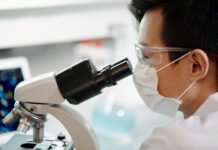To accelerate progress in labs all over the world, quantum mechanic Alán Aspuru-Guzik wants researchers to embrace laboratories that can make smart decisions all on their own. He calls them self-driving laboratories, and they combine chemistry with robotics and artificial intelligence to automate experiments, all the way down to automating decisions on what conditions to try next.
Aspuru-Guzik is the principal investigator of the Matter Lab at the University of Toronto and is cross appointed to both the Department of Chemistry and the Department of Computer Science. His multidisciplinary approach is one he hopes will spread.
“All of us scientists, we don’t take advantage of automation as much as we could,” says Aspuru-Guzik.
“So in my lab, we have been thinking a lot about how robotics and artificial intelligence can combine with chemistry to create something that we like to call self-driving laboratories: basically, a laboratory where, as much as possible, the mundane decisions of what the experiment to be done next, the next conditions to try, are actually optimized using artificial intelligence.”
Automating labs saves reagents, time, and other resources. Manually running experiments and stopping to analyze the data slows down progress, so automation fundamentally change the way we approach science.
He is starting with energy technology. From solar cells to batteries, every sustainable energy technology involves thin films of materials. So he built a machine to manufacture and test thin films made under different conditions to maximize their performance.
“Within five years, I would like my lab and my collaborators around the world to be able to demonstrate that these self-driving laboratories not only are successful, but they actually have positive change in the energy ecosystem,” adds Aspuru-Guzik.
He envisions that a laboratory in Taiwan might take his technology and find a better way to filter water, or that a scientists in Mexico might find a better molecule for energy regeneration. Worldwide reach would have limitless possibilities for rapid discovery.








































